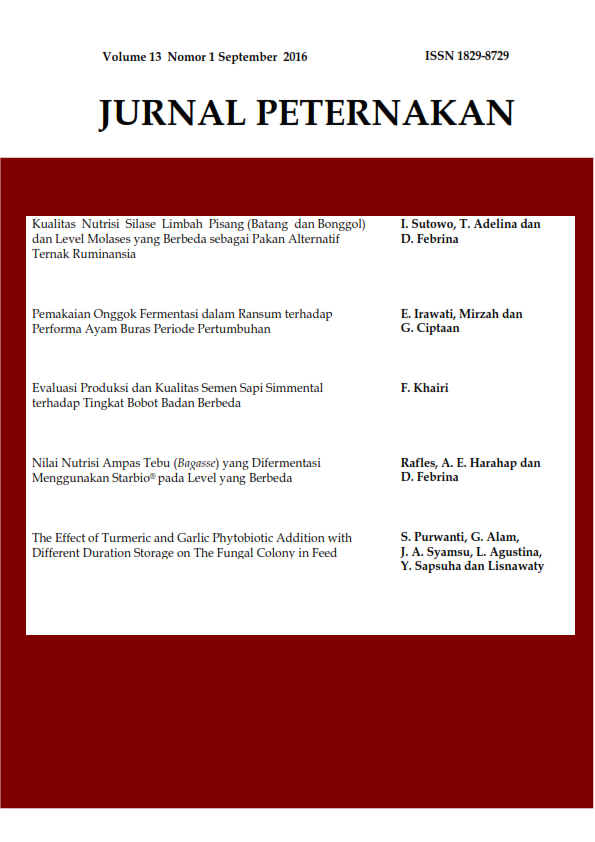KUALITAS NUTRISI SILASE LIMBAH PISANG (BATANG DAN BONGGOL) DAN LEVEL MOLASES YANG BERBEDA SEBAGAI PAKAN ALTERNATIF TERNAK RUMINANSIA
DOI:
https://doi.org/10.24014/jupet.v13i2.2417Keywords:
by product, fermentation, crude protein, crude fiberAbstract
Stem and stump of bananas have potential to be used as an alternative for ruminant feed. However, one of the problem is its rapidly decomposing which affect high of water content. The alternative way to solve this matter by using silage. The aim of this study was to determine the nutritional quality of banana waste silage (stems and stump) with the addition of molasses with different levels. The experimental design was a Completely Randomized Design in factorial 3 × 3 with two replications. The first factor (A) was the composition of the substrate, A1: stump 100% + stem 0%, A2: stump 50% + stem 50%, and A3: stump 0% + stem 100%, while the second factor (B) was the levels of molasses (0; 2.5; and 5%). The parameters measured were dry matter, crude protein, crude fiber, extract ether, ash and BETN. The results showed that the composition of the substrate has significant effect (P<0.05) increased content of dry matter, crude protein, crude fiber, BETN, but did not significant (P>0.05) on extract ether and ash content. There was an interaction (P<0.05) between the substrate composition and the addition of molasses on the content of the ash. The best composition for increasing the nutrient content was stump 100% + stemps 0%. It is conclude that the compostion of stump and stemps may affect the nutrient quality of silage.Downloads
Published
Issue
Section
License
The Authors submitting a manuscript do so on the understanding that if accepted for publication, copyright of the article shall be assigned to Jurnal Peternakan and published by Fakultas Pertanian dan Peternakan Universitas Islam Negeri Sultan Syarif Kasim Riau as publisher of the journal.
Authors who publish with this journal agree to the following terms:
Authors automatically transfer the copyright to the journal and grant the journal right of first publication with the work simultaneously licensed under a Creative Commons (CC BY) that allows others to share the work with an acknowledgement of the work's authorship and initial publication in this journal.
Authors are able to enter into separate permission for non-exclusive distribution of the journal's published version of the work (e.g., post it to an institutional repository or publish it in a book), with an acknowledgement of its initial publication in this journal.
Authors are permitted and encouraged to post their work online (e.g., in institutional repositories or on their website) prior to and during the submission process, as it can lead to productive exchanges, as well as earlier and greater citation of published work (See The Effect of Open Access).

